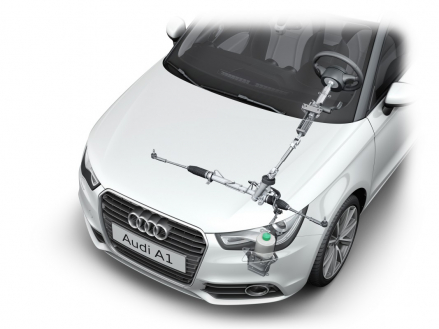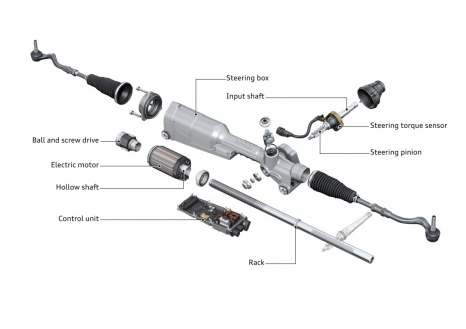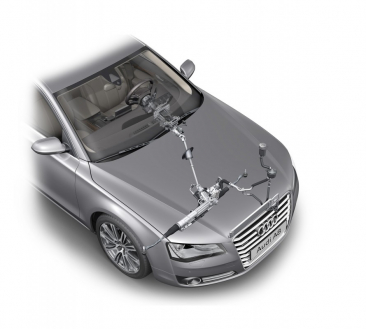Power steering
Steering systems are a technical field in which Audi invests a great deal of innovative know-how. Every model comes with standard power rack-and-pinion steering; its optional or standard power assist is based on the driving speed. In all cases, the driver experiences a firm, sporty feel at the wheel and precise, finely differentiated feedback from the road.
The differences among model lines stem from the technique used to generate the servo power. The A3 and TT families and the A6* and A7 Sportback all have an electromechanical solution on board. An electric motor generates the steering assist, and the system requires no hydraulic components at all. It consumes no energy when the car is traveling in a straight line, saving as much as 0.3 liters of fuel per 100 km.
The electromechanical power steering is integrated with the sensors of the ESP stabilization program. To mitigate the danger of skidding, it automatically makes slight corrections whenever the car is at risk of deviating from course during braking. It stops the driver from making steering corrections that would make the situation worse by temporarily reducing the power assist. Accurate corrections, on the other hand, are facilitated with increased servo power. Using the electromechanical power steering and attendant ultrasound sensors, the A3, A6 and A7 Sportback all back autonomously into the parking space during reverse parking.
In the A6 and A7 Sportback, the electromechanical power steering can also be equipped with Audi active lane assist, which helps the driver to stay in the lane. The park assist system in the full-size models is also a particularly powerful function.
The compact A1* makes use of its own technique – electrohydraulic power steering. Here a map-controlled electric motor delivers power steering fluid to the steering gear. As speed increases, the speed of the electric motor and thus the power assist decrease. With high steering angles (when maneuvering, for instance) the volumetric flow increases, and so does the power assist.
In the model families A4, A5*, A8, Q5, Q7* and R8, Audi employs hydraulic power steering, a technique in which the engine drives the pump. In most cases the pump is a demand-controlled vane pump. Unlike conventional servo pumps, which continuously circulate large volumetric flows, this pump only delivers as much fluid as needed for a given operating point. It also moves a smaller volume overall. This reduces fuel consumption by up to 0.1 liters per 100 km. The vane pump principle is simple: an eccentric cylinder (rotor) containing moving sliders revolves in a hollow cylinder (stator). A floating ring adjusts the amount of fluid supplied to suit current demands.
In all model lines with a longitudinally mounted front engine, the steering gear is mounted in the same position: deep and far forward, below and in front of the wheel center on the frame element for the engine and front suspension. Steering impulses are conducted directly into the wheels via the track rods. The response is spontaneous and precise.
*Audi A1: Combined fuel consumption in l/100 km: 7.1 – 3.8; Combined CO2-emissions in g/km: 162 - 99**
*Audi A5: Combined fuel consumption in l/100 km: 8.1 – 4.4; Combined CO2-emissions in g/km: 190 - 117**
*Audi A6: Combined fuel consumption in l/100 km: 9.6 – 4.4; Combined CO2-emissions in g/km: 225 - 114**
*Audi Q7: Combined fuel consumption in l/100 km: 10.7 – 7.2; Combined CO2-emissions in g/km: 249 - 189**
**Figures depend on the tires/wheels used.
Status: 2011


